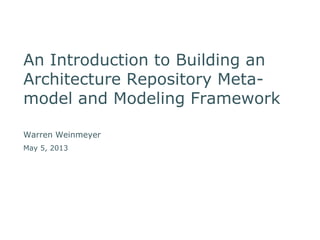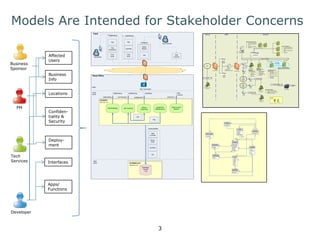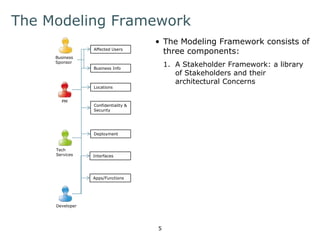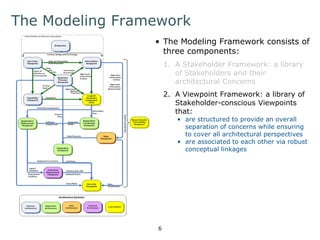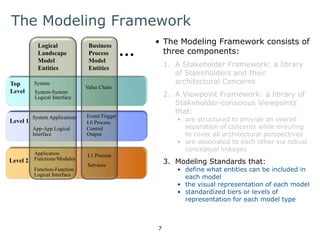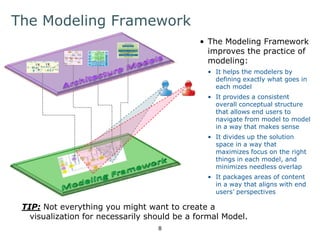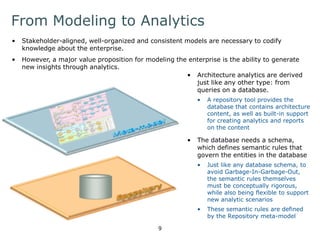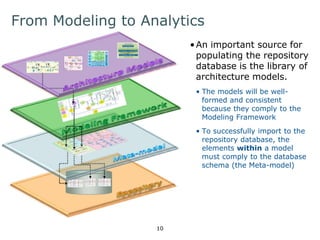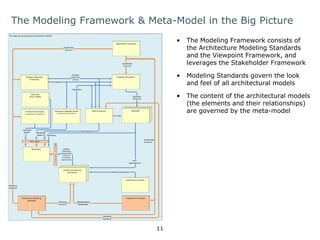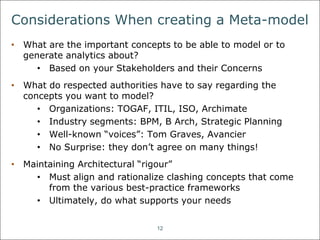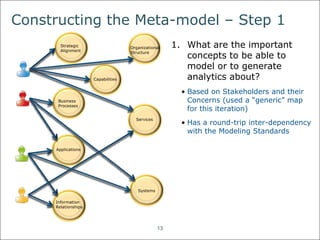An intro to building an architecture repository meta model and modeling framework
- 1. An Introduction to Building an Architecture Repository Meta-model and Modeling Framework Warren Weinmeyer May 5, 2013 Updated: Sep. 2014
- 2. Contents • The need for Models to be in sync • The Modeling Framework • The Meta-model • How these fit in the overall Architecture Framework • Considerations when creating a Meta-model 2
- 3. Models Must Address Stakeholder Concerns Stakeholders Concerns Models Business Rig Foreman Status Sponsor Report Job RigBooking JobBooking Rig Rig Schedule Cust-omer Rig Job/Well Cust-omer Well License Well License Search Equipment Maintenance SSL Terminator Status Reporting Rig Bookings Job Tracking Job PetroApp Oracle 11g Well License Equip-ment Booking Job sPrdVM1 168.192.1.13 Rig ActiveJobRec JobStatus Field wsBookRig wsTrackJob wsReportSt wsSrchLic sPrdDBClust1 168.192.0.27 Head Office DMZ Corp Zone Red Zone RigBooking JobBooking JobStatus Well License Rig Admin PM Tech Services Developer Who are affected Users Business Info at risk? What Locations are affected? Is Confiden-tiality & Security affected? What infrastructure is required? What Interfaces are required? What Data is processed? SolArc RA PC (5) (Citrix client) DMZ Red Zone Load Balancer Switch Citrix Access Gateway Farm (exist) Load Balancer Switch Active Directory Server (exists) SRA PC (15) (Citrix client) SRA PC (15) (Citrix client) Internet WAN SRA LAN PN (TELUS) 30 Mbits / Sec PN (TELUS) 45 Mbits / Sec Router Router Router Dundan LAN Durban LAN Core LAN - Datacenter Minimum IIS Server Spec: § 2 load-balanced servers § Win Server 2003 64-bit § IIS 7.0 § quad-core 2.3GHz cpu § 2GB RAM SAN Fiber Network SAN Storage SRA PC (Citrix clients) SRA Client PC Spec: § Windows XP Professional § Single P4 1.4GHz or Greater § 512MB RAM or higher Load Balancer Minimum RAMQ Spec: § 3 load-balanced servers § Win Server 2003 Ent Ed. 64-bit § quad-core 2.3GHz 64-bit cpu § 2GB RAM SRA SQL Server Cluster SQL Server (SECONDARY) Configured identically to PRIMARY Legend: New Existing Firewall Router Firewall Router Data Switch Minimum Intermediary File Server Spec: § Win 2003 Server, Std Ed., 64-bit § 1x quad-core 2.3GHz 64-bit cpu § 4GB RAM Minimum Workstation Spec: § Win XP 32--bit § dual-core 2.3GHz 32-bit cpu § 3GB RAM Minimum SQL Server (primary) Spec: § Win 2003 Server, Std Ed., 64-bit § SQL Server 2005, 64- bit § 2x quad-core 2.8GHz 64-bit cpu § 32GB RAM Router SRA Database § 200GB Well-License LicenseId Lead LeadId Status BookingId Contact ContactId 1 Operator OperatorId Booking BookingId StartDate EndDate RigId EquipId Location LocId LocDesc Lat Long Job JobId RigId Start End Well StatusRpt ReportId Equipment EquipId Drilling-Rig RigId N 1 1 1 N N N N N N N N N 0..N N 0..N N N N N 1 1 1 0 1 1 1 3
- 4. Models Need to be Sync’d to Each Other • Each model may be driven by stakeholder concerns, but if there is no overall organization to the models, then: • Some models may be too focused on a single stakeholder and so not enforce a more re-useable separation of concerns • There could be inconsistency in how models are visually presented • There could be a lot of unnecessary work from elements being redundantly modeled in multiple other models • Some valuable concepts might “fall through the cracks” and be covered by no model in particular • The negative impacts grow more significant as the number of models rises, and model “silos” develop • These issues are addressed by the Modeling Framework 4
- 5. The Modeling Framework • The Modeling Framework consists of three components: 1. A Stakeholder Framework: a library of Stakeholders and their Concerns (i.e. topics of particular interest) Business Sponsor PM Tech Services Developer Affected Users Business Info Locations Confidentiality & Security Deployment Interfaces Apps/Functions 5 Note: The Stakeholder Framework is a foundational framework that is leveraged in multiple activities; for example, for strategy creation, constructing a roadmap framework, identifying solution stakeholders, etc.
- 6. The Modeling Framework • The Modeling Framework consists of three components: 1. A Stakeholder Framework: a library of Stakeholders and their Concerns (i.e. topics of particular interest) 2. A Viewpoint Framework: a library of Stakeholder-conscious Viewpoints that: • are structured to provide an overall separation of concerns while ensuring to cover all architectural perspectives • are associated to each other via robust conceptual linkages 6
- 7. The Modeling Framework • The Modeling Framework consists of three components: 1. A Stakeholder Framework: a library of Stakeholders and their Concerns (i.e. topics of particular interest) 2. A Viewpoint Framework: a library of Stakeholder-conscious Viewpoints that: • are structured to provide an overall separation of concerns while ensuring to cover all architectural perspectives • are associated to each other via robust conceptual linkages 3. Modeling Standards that define: • what entities can be included in each model • the visual representation of each model • standardized tiers or levels of representation for each model type Top Level Level 1 Level 2 Logical Landscape Model Entities Business Process Model Entities System System-System Logical Interface System Applications App-App Logical Interface Application Functions/Modules Function-Function Logical Interface Value Chain Event/Trigger L0 Process Control Output L1 Process Services 7
- 8. The Modeling Framework • The Modeling Framework improves the practice of modeling: • It helps the modelers by defining exactly what goes in each model • It provides a consistent overall conceptual structure that allows end users to navigate from model to model in a way that makes sense • It divides up the solution space in a way that maximizes focus on the right things in each model, and minimizes needless overlap • It packages areas of content in a way that aligns with end users’ perspectives Driver Best Practice Proven Industry and Enterprise proces es, standards and methods guides guides Measure is realized by achieving inspires tactical y confirms achievement Action/Work Package Goal influences influences supports Concern is realized by executing Principle Mis ion influences Vision inspires strategical y Objective is realized by achieving Things important to the Stakeholder Cur ent is ues and chal enges Aspirational long-term future-state Concrete cur ent-state and near-future- state target High-level targets to achieve Mis ion Mid-level targets with clear succes criteria to achieve Goal Defined targets with concrete deliverables and outcomes to achieve Objective KPIs, Succes Indicators guides Guiding fundamental values for decision-making confirms achievement confirms achievement confirms achievement influences Strategy authorizes and constrains Mandate Confer ed authority and responsibility within a specific domain TIP: Not everything you might want to create a visualization for necessarily should be a formal Model. 8
- 9. From Modeling to Analytics • Stakeholder-aligned, well-organized and consistent models are necessary to codify • Architecture analytics are derived just like any other type: from queries on a database. • A repository tool provides the database that contains architecture content, as well as built-in support for creating analytics and reports on the content • The database needs a schema, which defines semantic rules that govern the entities in the database • Just like any database schema, to avoid Garbage-In-Garbage-Out, the semantic rules themselves must be conceptually rigorous, while also being flexible to support new analytic scenarios • These semantic rules are defined by the Repository meta-model knowledge about the enterprise. • However, a major value proposition for modeling the enterprise is the ability to generate new insights through analytics. 9
- 10. From Modeling to Analytics •An important source for populating the repository database is the library of architecture models. • The models will be well-formed and consistent because they comply to the Modeling Framework • To successfully import to the repository database, the elements within a model must comply to the database schema (the Meta-model) Driver Best Practice Proven Industry and Enterprise proces es, standards and methods guides guides Measure is realized by achieving inspires tactical y confirms achievement Action/Work Package Goal influences influences supports Concern is realized by executing Principle Mis ion influences Vision inspires strategical y Objective is realized by achieving Things important to the Stakeholder Cur ent is ues and chal enges Aspirational long-term future-state Concrete cur ent-state and near-future- state target High-level targets to achieve Mis ion Mid-level targets with clear succes criteria to achieve Goal Defined targets with concrete deliverables and outcomes to achieve Objective KPIs, Succes Indicators guides Guiding fundamental values for decision-making confirms achievement confirms achievement confirms achievement influences Strategy authorizes and constrains Mandate Confer ed authority and responsibility within a specific domain 10
- 11. The Modeling Framework & Meta-Model in the Big Picture • The Modeling Framework consists of the Architecture Modeling Standards and the Viewpoint Framework, and leverages the Stakeholder Framework • Modeling Standards govern the look and feel of all architectural models • The content of the architectural models (the elements and their relationships) are governed by the meta-model The Open Group Architecture Framework (TOGAF) Stakeholder Framework Strategic Alignment Framework Roadmap Framework Repository Roadmap Attributes Architecture Principles Stakeholder Concerns Enterprise Capability Model Models (Capabilities, Strategy Maps, Processes, Landscapes, Deployments) Stakeholder Concerns Strategic Alignment Criteria RRoaodamdmapap Roadmap Solution Architecture Description Solution Guidance Viewpoint Framework Standardized Viewpoints Architecture Modeling Standards Modeling Guidance Stakeholder Concerns Inter-dependencies Enterprise Landscapes (created directly in Repository) Roadmaps (created directly in Repository) Capability Models Capabilities APM Framework Strategy Modeling Guidance M e t a - m o d e l Bulk Data (from CMDB) Landscape Models APM Models Modeling Guidance Stakeholder Meta-model Concerns 11
- 12. Considerations When creating a Meta-model • Think about what are the important concepts to be able to model or to generate analytics about? • Is based on your Stakeholders and their Concerns • Avoid going maverick: what do respected authorities have to say regarding the concepts you want to model? For example: • Organizations: TOGAF, ITIL, ISO, Archimate • Industry segments: BPM, B Arch, Strategic Planning • Well-known “voices”: Tom Graves, Avancier • No Surprise: they don’t agree on many things! • Maintain Architectural “rigour” (i.e., conceptual clarity) • You will likely merge concepts from more than 1 framework: you must align and rationalize concepts (for example, “Service” in ITIL vs TOGAF) • Good analytics is impossible without architectural rigour • Ultimately, do what addresses your organization’s needs 12
- 13. Constructing the Meta-model – Step 1 13 1. What are the important concepts to be able to model or to generate analytics about? • Based on your Stakeholders (roles, not people) and their Concerns (i.e. topics of particular interest) • The right way to enumerate Concerns is through interviews: a lot of work, but is heavily reusable because Concerns tend to be pretty persistent • When interviewing isn’t possible, you can identify standard types of Concerns (for example, a PM is always interested in time, risk and cost) What Capability is affected? What Bus. Processes are affected? What are the required Service levels? What Applications are involved? What Information Is Processed? How is the Org Structure affected? Is this Strategically Aligned? Capabilities What Systems are involved? Strategy Business Processes Services Systems Info Entities Org Structure Applications Stakeholders Concerns Concepts (entities)
- 14. Constructing the Meta-model – Step 2 Organiza-tional Structure 14 2. What do various “authorities” say about these concepts? • The foundation is built on an architecture framework, such as TOGAF • Other frameworks may also be relevant, like ITIL – Or, you may need to beef up the meta-model somewhere (for example, with BMM or EBMM) • Select ideas that align to addressing your requirements • Will have to make decisions when concepts don’t align – Which concepts are crucial to a given framework (eg. “Service” in ITIL) Strategic Alignment Business Processes Capabilities Services Information Relationships TOGAF Business Motivation Model ITIL Applications Systems Archimate
- 15. Constructing the Meta-model – Step 3 15 3. Define the Entities for each concept and the Associations between them • Leverage the short-listed reference frameworks • May need to customize at the boundaries where the frameworks get merged • Minimal best practices exist – is a type of data modeling – a “complete” meta-model will have between 30-50 entities – a “balanced” meta-model will have between 40-60 associations (approx. 1.5/entity) • Getting the meta-model wrong will undermine your Analytics and lead to bad guidance Business Function Functional purpose of a Business Unit Ente r p rise 1..* 1 Organization Unit 1 Ac t o r 0..* 0..* Role 1 1 1..* Location 1 1..* 1..* contained in contained in contained in 1..* 1..* 1..*
